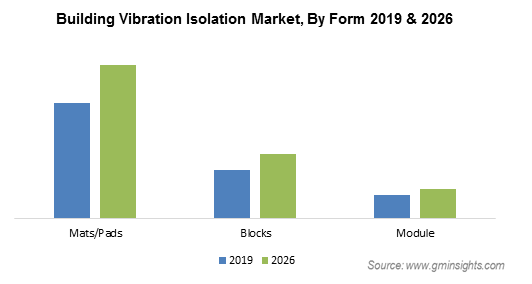Building Vibration Isolation Market size worth over $2.5 Bn by 2026
Published Date: July 2020
Building Vibration Isolation Market revenue is forecast to exceed USD 2.5 billion by 2026; according to a new research report by Global Market Insights.
The growing demand across the commercial sectors is one of the major factors driving the industry growth. Moreover, the rising adoption of the product in the residential and industrial sector due to increasing popularity and need for energy-efficient products & green building is also boosting the market value during the forecast period.
Structure-borne noises and vibrations are major factors driving the demand for vibration isolation systems in buildings. The rising commercial construction activities in the emerging economies along with the increasing demand for products from these customers is expected to spur the industry growth. Moreover, excessive noises and vibrations are much more common in densely populated areas due to the underground or above rail lines and industrial areas.

Get more details on this report - Request Free Sample PDF
These vibration isolation products offer various advantages such as increased stiffness, low frequency isolation, and easy & quick installation among others. Increasing building and construction activities in emerging nations together with the growing trend of energy efficient buildings is another reason propelling building vibration isolation market demand across the globe.
Several countries are implementing various policies which are intended at mitigating greenhouse gas emissions. Many countries across the globe have enacted legislation establishing requirements for GHG emissions reduction. Some of the American states including North Carolina, Pennsylvania, and New Mexico have committed to GHG reduction goals at state level through executive actions but do not have binding statutory targets as of now. Europe is focused on to meet its target of emissions reduction for 2020 and has set up a legislation to achieve its 2030 climate and energy targets.
Browse key industry insights spread across 645 pages with 1078 market data tables & 29 figures & charts from the report, “Building Vibration Isolation Market Size By Material (Cork & Natural Rubber Engineered Compound, Resin Bonded Cork & Recycled Rubber, Resin Bonded Recycled Rubber, Virgin Polyurethane), By Form (Mats/Pads, Blocks, Module), By Applications (Floating Floor, Box-in-box, Two Tier Construction, Building Bearing, Elastic Bearing of Stairs And Landings, Separation of Individual Building Parts), By End-Use (Residential, Commercial, Industrial), Industry Analysis Report, Regional Outlook, Application Potential, Price Trends, Competitive Market Share & Forecast, 2020 – 2026” in detail along with the table of contents: https://www.gminsights.com/industry-analysis/building-vibration-isolation-market
Mats/Pads segment will hold over 60% building vibration isolation market share in 2026
Vibration isolation mats/pads will showcase significant growth owing to excellent properties such as high coefficient of friction, good aging characteristics, level stability, and high load-bearing capacities which makes it suitable to high frequency vibration. The segment is projected to hold a dominant share of close to 60% in 2026.
Vibration isolation mats/pads can be used to reduce noise, high frequency vibration, and impact from machinery. Neoprene pads with ribbed or waffle-pattern surfaces are effective as high frequency isolators in series with steel springs. The pads are effective as isolators because the ribs provide some shearing action, and spaces between the ribs allow lateral expansion as an axial load is applied.
The module segment held around 13% building vibration isolation market share in 2019 and is projected to grow at 4% CAGR during 2020 to 2026. Vibration isolation modules are mostly used in industrial sector owing to their excellent stiffness and low cost.
North America and Europe to exhibit steady growth during the forecast period
North America held the largest market revenue share of around 35% in 2019 and is anticipated to maintain its dominance throughout the projected timeframe. The regional market is majorly driven by the rising investment in residential construction and growing demand for remodeling the old buildings within the region. In Europe, the stringent regulations regarding greenhouse gas emissions from buildings are expected to drive the demand for building vibration isolation. Europe is likely to hold a prominent share of 30% by 2026.
The key participants of the global building vibration isolation market are mainly focused on various investments to hold a strong product portfolio and market share. Companies such as Getzner is majorly investing in research & development activities. As a result, the company recently launched a g-fit range that provides effective protection against sound and vibration in fitness gyms & studios. Moreover, KRAIBURG PuraSys GmbH invested a huge amount in product line expansion. The company is currently investing in eco-friendly products.
Some of the key product producing companies include Getzner, Kraiburg, Regupol BSW GmbH, VibraSystems Inc., Acoustics Control Engineers, Mason industries Inc, Farrat, ALPHA ACOUSTIKI Ltd, GMT Rubber-Metal-Technic Ltd, VMC Group, California Dynamics Corp, Vibration Eliminator Co., Inc., SEBERT SCHWINGUNGSTECHNIK GMBH, ACE STOSSDÄMPFER GMBH, ITT Endine INC, APLICACIONES MECANICAS DEL CAUCHO SA, and Maurer SE among others.





